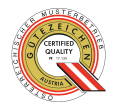Wear types of milling cutters
Wear type
Actions
Flank wear
wear between the workpiece and the flanks
✓ Reduce cutting speed (Vc)
✓ Increase feed rate (fz)
✓ Increase coolant pressure

Built-up edge
Parts of the material adhere to the cutting edge due to welding
✓ Increase cutting speed (Vc)
✓ Reduce feed rate (fz)
✓ Increase coolant pressure
✓ Use tool with a sharper cutting edge

Breakouts (along the cutting edge)
are caused by vibrations, chip jams, thermal cracks and excessive brittleness of the material
✓ Reduce cutting speed (Vc)
✓ Increase feed rate (fz)
✓ Increase coolant pressure
✓ Use tool with edge preparation e.g. VSO

Plastic deformation
due to too high temperatures and too high mechanical stresses
✓ Reduce cutting speed (Vc)
✓ Reduce feed rate (fn)
✓ Increase coolant pressure

Wear types of drills
Wear type
Actions
Flank wear
wear between the workpiece and the flanks
✓ Reduce cutting speed (Vc)
✓ Increase feed rate (fn)
✓ Increase coolant pressure

Built-up edge
Parts of the material adhere to the cutting edge due to welding
✓ Increase cutting speed (Vc)
✓ Increase feed rate (fn)
✓ Increase coolant pressure

Breakouts (along the cutting edge)
are caused by vibrations, chip jams, thermal cracks and excessive brittleness of the material
✓ Change tools in time and have them
reconditioned (WEDCO Service)
✓ Check tool clamping (vibrations)
✓ Check tool concentricity
✓ Reduce cutting speed (Vc)
✓ Reduce feed rate (fn)

Plastic deformation
due to too high temperatures and too high mechanical stresses
✓ Reduce feed rate (fn)
✓ Reduce cutting speed (Vc)
✓ Increase coolant pressure

General hints
– Check concentricity when tool is clamped
– Check workpiece clamping and cleanliness of clamping surfaces
– Check tool clamping
– Correct choice of tools (pay attention to the ISO material groups when selecting tools)
Our experts will be happy to answer any further questions





